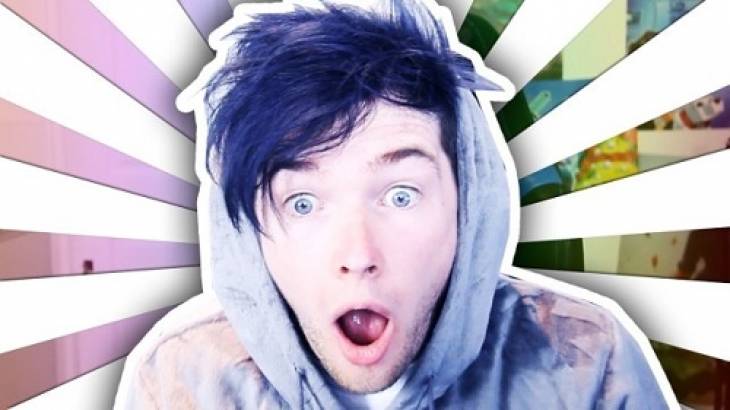The Top 10 YouTube Creators of 2017 Earned a Total of $127 Million

YouTube star DanTDM — 14.4 million subscribers.
The top 10 YouTube stars made cumulative earnings of $127 million between June 1, 2016 and June 1, 2017, up 80 percent from the same period the year before, according to Forbes’s annual list of the world’s 10 highest-paid YouTubers. And that's just their YouTube revenue before other revenue sources are included. Top YouTube stars also have affiliate commerce businesses, organize sold-out events across the world, and drive brick-and-mortar crowds as well, minting millions in the process.
2017 Top Earning YouTube Creators
According to Forbes, which based its 2017 figures on data from YouTube, Social Blade and Captiv8, as well as interviews with agents, managers, publicists, producers and lawyers, sheer video views that ultimately translate to advertisement dollars drove this figure.
YouTube stars have also become more sophisticated in marketing themselves, leading to bigger tours, more lucrative branded content deals and higher merchandise sales, Forbes said.
“What’s cool about YouTube, unlike TV, is that there isn’t that competition element. I mean, you could make it into that, as there’s obviously numbers involved, but people are free to watch whoever they want,” YouTube sensation Daniel Middleton, who boasts over 11 billion views on YouTube, told the Guardian last year.
Middleton ranks as the world’s highest-paid YouTuber of 2017 with $16.5 million before management fees and taxes—the highest cumulative of any YouTube star since Forbes started keeping track in 2015.
The top 10 highest-paid YouTuber stars of 2017 are:
- Daniel Middleton (DanTDM) — $16.5 million
- Evan Fong (VanossGaming) — $15.5 million
- Dude Perfect — $14 million
- Logan Paul — $12.5 million
- Mark Fischbach (Markiplier)— $12.5 million (tie)
- Felix Kjellberg (PewDiePie) — $12 million
- Jake Paul — $11.5 million
- Smosh — $11 million (tie)
- Ryan ToysReview — $11 million (tie)
- Lilly Singh — $10.5 million
Meanwhile, as top YouTubers rake in millions annually selling books, make-up, or reviewing video games and TV shows, dozens more smaller creators struggle to generate revenue on the platform.
Smaller YouTubers Struggling to Make Ends Meet
The rest of YouTube’s working class has mixed fortunes on the site. Recent brand-safety outcries from advertisers has forced YouTube to quickly demonetize or limit ads on potentially controversial content such as those with curse words or violence as the company seeks to appease and close bigger deals with advertisers. This crackdown on “inappropriate material for advertising” has cut revenue for smaller YouTubers, hurting the very people who helped make the site the most popular place to watch video online.
Not all creators caught in YouTube’s dragnet have flagrant content. And yet reports indicate a YouTube bot keeps demonetizing videos within a few hours of uploading, depriving creators of as much as 80 percent of their monthly revenue. Some say they can’t make ends meet under current standards.
“I’ve had to change my whole life around,” Joe Taylor, who operates a motorcycle-focused channel called JoeGo101 told Bloomberg. Taylor’s earnings have fallen from $6,000 a month to about $1,000 a month, not enough for the 37-year-old to pay the bills. “There are so many people who can’t post as much because they had to go get jobs. They have fired thousands of people in one fell swoop.”
Another batch of YouTube creators say their earnings haven’t been affected by the ongoing videos demonetization and that the changes may actually make YouTube cleaner and safer. But, they’re still frustrated by what they say is the company’s lack of transparency and communications. YouTube has yet to provide a clear set of standards of what’s acceptable for advertisers.
Mixed Fortunes for YouTube Video Creators
The Google-owned video-sharing site has built one of the largest advertising businesses in the world, with billions of dollars in annual revenue. The site relies on relative unknowns to provide it with free video clips. The incentive for creators is to build an audience and share in ad proceeds as their viewership grows. Some creators are, however, reconsidering their participation as they benefit less from the symbiotic relationship.
A real concern for many creators seems to be that they don’t understand why particular videos get demonetized. YouTube suggests creators upload videos as unlisted or private to check the monetization status before a video goes public, something creators of timely news and reviews aren’t excited about.
Despite these challenges, YouTube says total creator revenue is up “significantly” year over year. YouTube channels making six figures or more in revenue are up 40 percent over last year, according to the company. And six of the 10 celebs on Forbes annual list are newcomers. Creators also have new ways to make money through subscriptions, sponsorships and other tools, YouTube says.
See Also: YouTube Limits Creators from Monetizing Videos Until They Reach 10,000 Views.




















